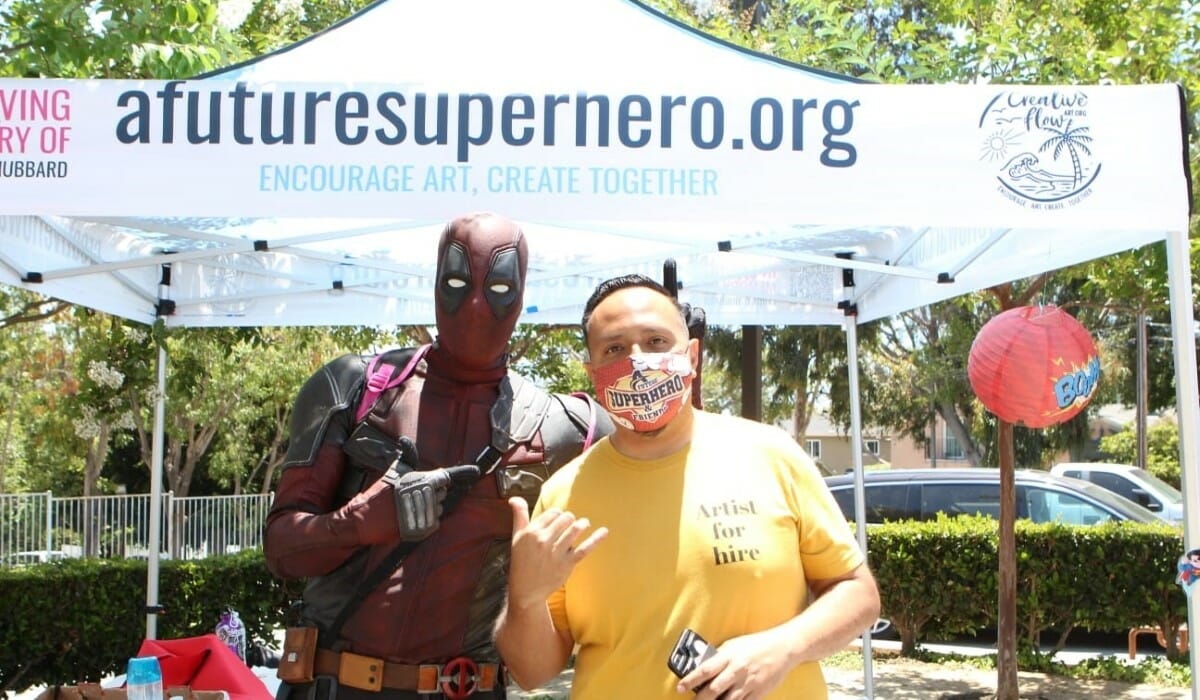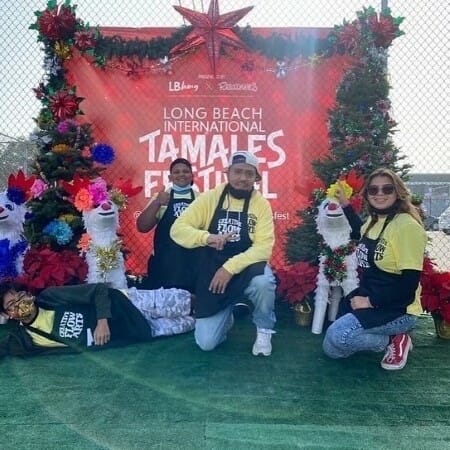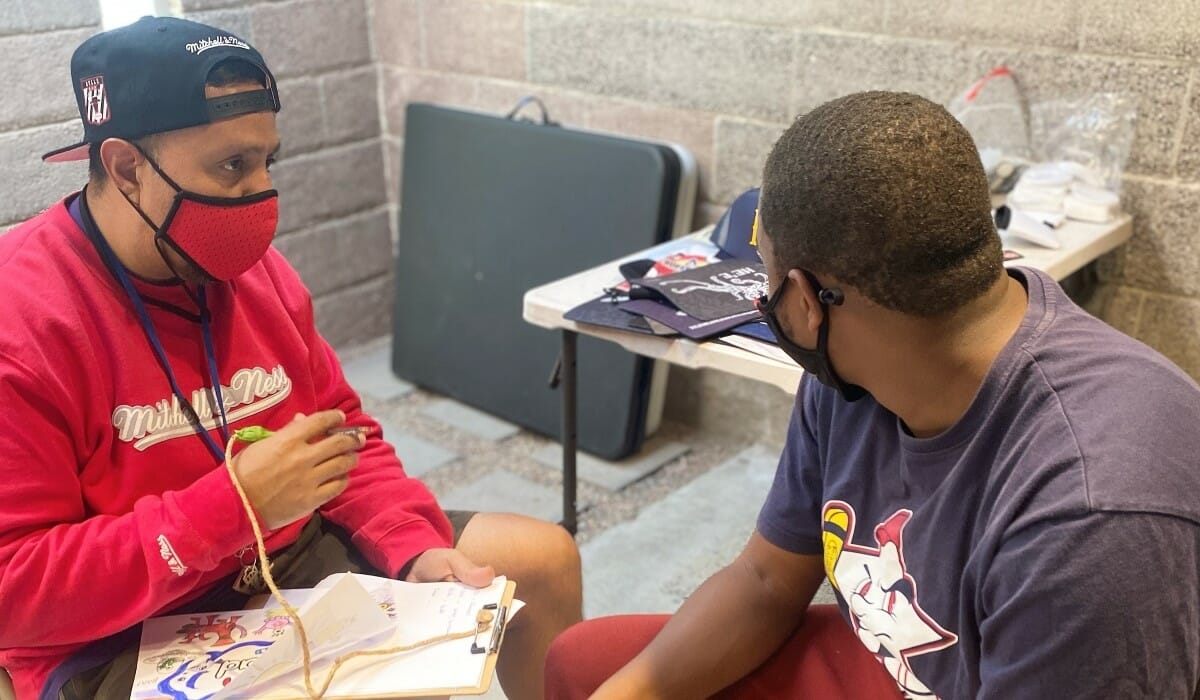Artist Helps Long Beach Youth Turn Their Passion for Art into Careers

Meet Daily Point of Light Award honoree Juan Carlos Alfaro. During the third annual Global Volunteer Month, we celebrate the power of people who tackle society’s greatest challenges, and build stronger, more vibrant communities through volunteerism and everyday actions, like Juan Carlos. Read his story, and join the Global Volunteer Month celebration.
Growing up in Long Beach, California, Juan Carlos Alfaro always found art to be an escape for him but never thought he could make a career out of it. Now that he has found professional success as an artist, he is making sure that kids who are in the same position he once was know that they do have an option to turn their passion into a living. Since 2017, Juan Carlos has led Creative Flow Art, an art-based youth mentorship program within the nonprofit A Future Superhero and Friends.
Through Creative Flow Art, Juan Carlos mentors youth aged 15 to 23 who have a passion for art through a six-week program that focuses on offering project-based learning and hands-on experience. The program also provides community workshops and a mobile art station for community events. Juan’s goal is to personally help 100 students to find a career in art.
Describe your volunteer role with Creative Flow Art.
I started Creative Flow Art. It’s a program to encourage kids and let them know art is not a hobby; you can actually make a living. [Art is] how I pay all my bills and go on vacations. That’s a core part of it — going into the community and uplifting youth and letting them know from an early age that, hey, you can work for Disney, you can work for Nike, you can work for all these companies if you want to be an artist.
What inspired you to start Creative Flow Art?
I saw a need in the community for kids to be pushed in the arts as a career. Growing up in the late 80s and early 90s, I knew I was creative, but there were no outlets or programs that told me I could take that creativity and actually make a living. As an immigrant kid, I was told I had to go to school, and I had to work. As I struggled through school and struggled with what I was going to do, and also being an immigrant kid, I was like, what is there for me? Now that I have become an artist for a living, I wanted to give back to the community — specifically Long Beach, because that’s where I grew up.

How important is it for kids interested in art to have an outlet like Creative Flow Art?
The importance of them having an outlet like this is the fact that a lot of these kids don’t have this guidance or support at home. They’re going to look for it somewhere else. A lot of times, they find it with their friends, and their friends are sometimes up to no good. Having a program like this — where an individual comes in, they’re really shy and they don’t want to talk, and then they find themselves with 12 or 15 other kids with the age ranges of 15 to 23, and they love art, and they’re in there for the same reason. It gives them a really good feeling that they’re going to be okay at pursuing their dreams and what they want to do in their career.
Do you have any goals for Creative Flow Art?
My goal is to open a center and possibly starting a screen print shop where we can employ some of the kids, whether they’re printing or designing. Somewhere the public can come and get their t-shirts or websites done. At the same time, continue to grow kids and have them come in, and maybe split up our classes for newer kids and our older kids. At the nonprofit where I was working, they would age out. I would say, well, what happened with all these kids? They would say, ‘We don’t know, they can’t participate anymore, so we can’t help them anymore.’ It blew my mind. These are kids you’ve worked with for maybe three years, how do you just not talk to them again? So my goal would be to get a center where I can maybe get a design studio and continue the education part of the program.
What’s been the most rewarding part of your work?
The most rewarding part was when I helped the first kid out. I see myself in him, because his family are immigrants. Him being able to better himself financially and mentally, I think that has been the biggest reward. Here you have a kid who was absolutely not going to college, regardless of how much I told him how important it was to get that piece of paper. I knew he wasn’t going to go. I always told him, you could get a job at a fast food place, or I could help you get a job where you can start off at a pretty good rate, money-wise, and have a career that is going to continue to thrive for you and take you places. Seeing him graduate from high school and, whenever he gets a chance, him just thanking me without me even asking him – I think that’s been the most rewarding part. It’s also the part that has kept me going, because I would love to have that same feeling with more kids.

How can people help Creative Flow Art?
We do take volunteers. If anybody wants to volunteer, we just ask that you are working in the industry somehow – whether you’re a graphic artist, animator or anything that you feel that our youth will take. When we have a guest, I always say, ‘You guys have to be like a sponge and take it in. Later on, whatever doesn’t work for you, toss it out, but I guarantee you guys are going to learn something from our guests.’ I just ask that our guests are in the art industry somehow, because our kids will definitely take their experiences and really get inspired. Who knows, maybe if we have an architect, one of my kids will become an architect.
What do you want people to learn from your story?
What I learned myself is that there are a lot of people out there who want to do good in their community and they don’t know how. I always thought that being a police officer was how you would do it. … Once I started doing this, I realized you don’t have to be a servant to help the community. What I run across a lot is that people don’t know how, or they want to do it, but they just don’t have the energy. They just don’t do it. I think what people should learn from me is to get up and volunteer with someone and find a cause that’s deep in your heart, something that you feel you would like, and then just go from there. You’ll find your purpose once you’re in the right place. From there, it’s all good. It’s so rewarding to work with people and help people and not be so selfish. Put yourself out there.
Do you want to make a difference in your community like Juan Carlos? Find local volunteer opportunities.
